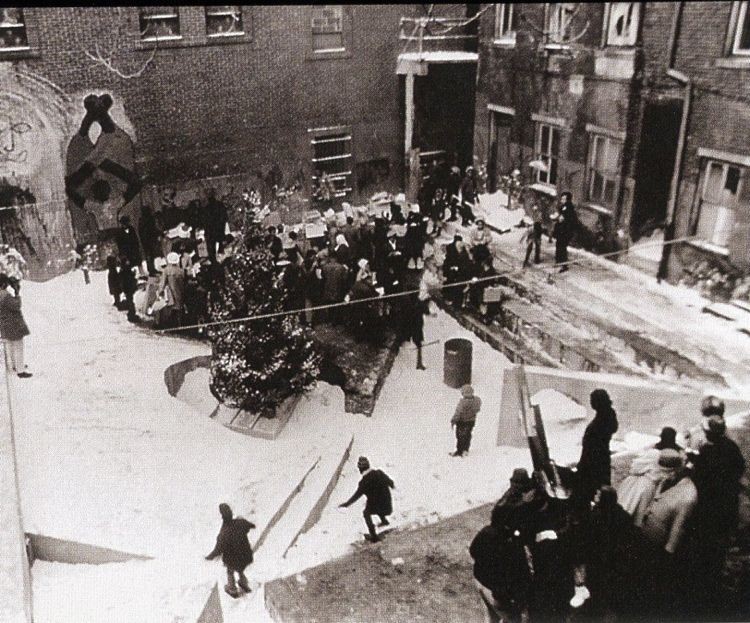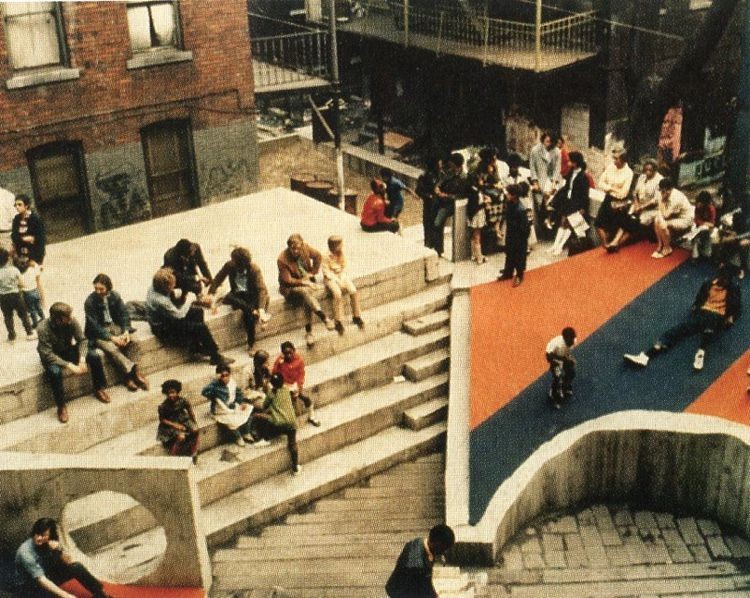Small urban spaces, Neighborhood commons and Community Design Centers
Three seminal works challenged the orthodox modernist thinking about planning, environment, and architecture and pointed at a growing discontent with the fate of the American City and the state of the environment: Jane Jacobs‘ Death and Life of Great American Cities (1961), Rachel Carson’s Silent Spring (1962), and Robert Venturi’s Complexitiy and Contradiction in Architecture (1966) (Schuman 2).
Communities opposed urban renewal and slum clearance projects, and claimed to be involved. They were joined by students and professionals who fought against discrimination which had produced a divided society and, as its counterpart, a devided residential landscape (Schuman 2). Planners, architects, engineers and scholars formed groups to provide pro bono planning services to underserved neighborhoods.
Landscape architect Karl Linn pioneered in designing and building neighborhood commons – urban gathering and play spaces – in Philadelphia, starting in the 1960. Later, the emphasis of his projects shifted from designing and building spaces to empowering communities (Linn 106).
The Architects’ Renewal Committee in Harlem (ARCH) was founded in 1964 and existed until 1975. It served as the first community design center in the country, a resource to assist residents in planning alternatives to state-led redevelopment projects threatening to destroy neighborhoods. In its early years, ARCH opposed disruptive urban renewal plans but not renewal itself, arguing that Harlem could use public resources to reconstruct neighborhoods for the benefit of existing residents (Goldstein 4). ARCH later provided a youth training program in architectural skills.
Service learning and reach out to the community service became part of the academic program in architecture, landscape architecture and city planning at some Universities. Teams at among Harvard and MIT offered free technical assistance to community groups in low-income areas.
In Pittsburgh, architect Troy West, then an assistant professor in the Department of Architecture at Carnegie-Mellon University established Architecture 2001 (located at 2001 Central Avenue in the Hill District) in 1967 as a community studio. He began the project in response to students’ questions about why the architecture program was not engaged in the city they lived in. The principal project was a renovation of a junk-strew lot into a „ Court of Ideas“ with murals, performance space, and sitting areas. (Schuman 4). They went on with a youth drug-rehabilitation program based on architecture. With the advent of the Nixon administration, funding began to dwindle, and the program ended in 1973 when West lost his teaching position (Linn 115). He then moved on to the newly established School of Architecture at New Jersey Institute of Technology, Newark, where he was joined by Karl Linn who developed a community design-and-build service eduction program.
Best known among many service learning programs at Universities is Rural Studio , „an off-campus design-build program of Auburn University. The program, established in 1993 by D.K. Ruth and Samuel Mockbee, gives architecture students a more hands-on educational experience whilst assisting an underserved population in West Alabama’s Black Belt region.“
Bibliography
Anthony W. Schuman: The Pedagogy of Engagement, in: Hardin, Mary C, Richard A. Eribes, and Corky Poster. From the Studio to the Streets: Service-learning in Planning and Architecture. Sterling, VA: Stylus, 2006.
Karl Linn: Building Commons and Community. Oakland, CA: New Village Press, 2007.
Andrew Freear et al., Rural Studio at Twenty : designing and building in Hale County, Alabama, 2014
Andrea Oppenheimer et al., Rural Studio : Samuel Mockbee and an architecture of decency, 2002
Brian Goldstein, A City Within a City: Community Development and the Struggle Over Harlem, 1961-2001, 2012
Playgrounds Rural Studio:
Lions Park Playscape 2010
Lions Park Skatepark 2009
Lions Park Surfaces 2007
Architectural Record: Lions Park Playscape. By Joann Gonchar, AIA, March 2012
Newbern Playground 2001
Hero Playground 1997
published December 9, 2013

Troy West, Ed Ellis: Court of Ideas, Pittsburgh, c. 1965

Troy West, Ed Ellis: Court of Ideas, Pittsburgh, c. 1965